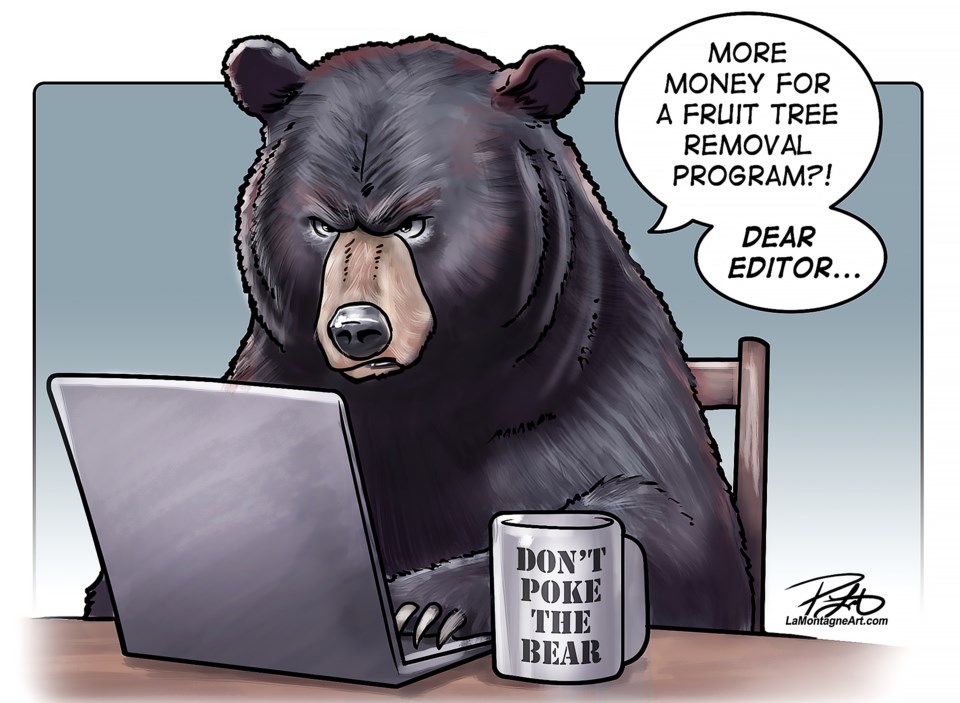Bow Valley residents pride themselves on their relationship with wildlife and the responsibility of maintaining proper human-wildlife interactions.
One only has to see how locals and some visitors act when near wildlife, whether it be deer, elk or bears in Bow Valley communities or on hiking trails.
With this in mind, there should be no doubt many residents would leap in support at removing all fruit trees on public and private land in a single season.
But in attempting to reduce the impact of human-wildlife interactions comes a large price tag.
In Canmore, the cost to remove and replace all fruit trees and shrubs is estimated at $1.65 million on private property. With a projected 400 crabapple, mountain ash and choke cherry trees on public land, the forecasted removal of those would be between $160,000 to $180,000.
The Town of Banff and Parks Canada have been aggressive for many years in removing fruit trees. There are about 40 crabapple trees remaining in the townsite with the Town’s fruit tree replacement program coming up on about 10 years of activity.
Though there’s support for the programs, it’s not until high profile instances take place that people wake up and feel the weight of their decisions in relation to wildlife entering the two towns.
Earlier this fall, bear 122 – popularly known as The Boss – was in the Banff townsite on several occasions. First to enjoy a meal of a mule deer carcass and then a dessert of apples in a backyard in Marmot Crescent.
The potential loss of The Boss – the male patriarch of grizzly bears in the Bow Valley and a legend among area wildlife – struck a chord with Banff residents.
In a three-week period after those incidents, 15 tree removals took place after there had been 22 removed in the previous eight years.
Canmore faced a similar incident that generated significant attention when a mama black bear and her three cubs were relocated after eating fruit from trees and accessing a garbage bin downtown.
The four black bears were moved to Caroline – more than 200 kilometres from Canmore – and returned within about two weeks, albeit with one of the cubs presumed to have died on the trek.
Habituated to humans, the decision to euthanize the bears was made to avoid a future public safety incident.
Further hampering the situation is the reality that when a bear is relocated, its chances of survival are only about 30 per cent with it struggling to adapt to new territory that could potentially already have other bears.
With the incident in recent memory, it’s little surprise the fruit tree removal program was fully subscribed this past year in Canmore.
The $10,000 budget led to 94 fruit trees being removed and replaced on private property. The budget makes a slight dent in what a 2018 survey found was about 2,500 fruit trees in the community.
Canmore’s finance committee recommended council approve a $30,000 budget in 2024 and potentially continue each year through 2028 to remove and replace those fruit trees on public land. The Biosphere Institute of the Bow Valley also has a sizeable grant request, which could offer financial help in removing fruit trees, but council chose to revisit the $10,000 budget for fruit tree removal on private lands if fully subscribed in 2024 rather than increase it.
Though grizzly bears are often the focus of people, largely due to the scarcity of the population, the fruit trees impact all walks of wildlife from deer, elk, wolves and many other species.
For people to truly respect wildlife, it’s a responsibility for residents to do what they can to minimize interactions.
Having bear spray and respecting proper distances from wildlife is helpful, but it’s incumbent on those who live in the Bow Valley to take the next step and remove fruit trees to show they acknowledge the responsibility of living with wildlife.




